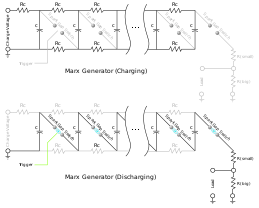

 pm01@hvhipottester.com
pm01@hvhipottester.com  pm02@hvhipottester.com
pm02@hvhipottester.com  8618986157274
8618986157274  +86 18986157274
+86 18986157274  live:1379417129
live:1379417129 1379417129
1379417129 What is Marx generator-Impulse gernerator

A Marx generator is an electrical circuit first described by Erwin Otto Marx in 1924.Its purpose is to generate a high-voltage pulse from a low-voltage DC supply. Marx generators are used in high-energy physics experiments, as well as to simulate the effects of lightning on power-line gear and aviation equipment.

Marx generator diagrams; Although the left capacitor has the greatest charge rate, the generator is typically allowed to charge for a long period of time, and all capacitors eventually reach the same charge voltage.
Marx generator used for testing high-voltage power-transmission components at TU Dresden, Germany
To deliver 5 ns rise time pulses, the Marx generator is often built into a coaxial wave guide. The spark gaps are placed as close as possible together for maximum UV light exchange for minimum jitter. DC HV comes from underneath, pulsed HV leaves at the top into the coaxial line. The double line of spheres in the middle are the spark gaps, all other spheres are to avoid corona discharge. Blue=water capacitor. Grey=solid metal. Black= thin wire. The outer conductor also functions as a vessel, so that the gas and the pressure can be optimized.
Applications
One application is so-called boxcar switching of a Pockels cell. Four Marx generators are used, each of the two electrodes of the Pockels cell being connected to a positive pulse generator and a negative pulse generator. Two generators of opposite polarity, one on each electrode, are first fired to charge the Pockels cell into one polarity. This will also partly charge the other two generators but not trigger them, because they have been only partly charged beforehand. Leakage through the Marx resistors needs to be compensated by a small bias current through the generator. At the trailing edge of the boxcar, the two other generators are fired to "reverse" the cell.
Marx generators are used to provide high-voltage pulses for the testing of insulation of electrical apparatus such as large power transformers, or insulators used for supporting power transmission lines. Voltages applied may exceed two million volts for high-voltage apparatus.
Quoted from Wikipedia